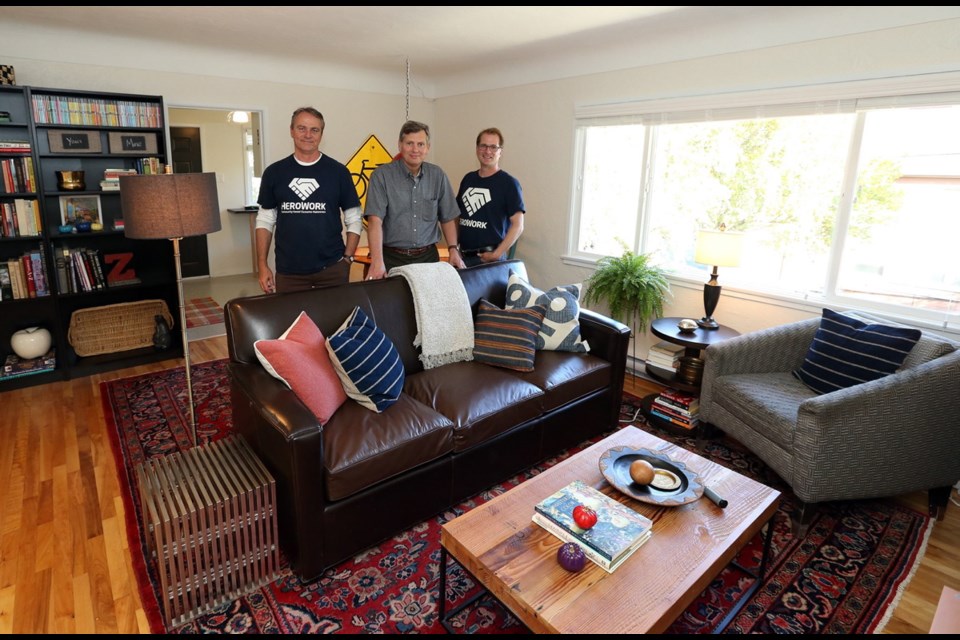Six homeless youth will move into a newly renovated building with a life-skills teaching space in the coming weeks, thanks to a massive community makeover of the donated four-unit apartment complex.
“I can’t express my gratitude enough and also my amazement at the transformation,” said Mark Muldoon, executive director of Threshold Housing Society, which helps and houses youth ages 16 to 21 who are at risk of homelessness or in government care.
He was in awe at the Sunday reveal of the building’s extreme makeover, co-ordinated by the Hero Work society. The scene was like something out of a home-renovation TV show.
A large truck blocking the view of the two-storey building on Davie Street, near Royal Jubilee Hospital, was pulled away. Members from the Threshold society stepped inside and their reactions were recorded and livestreamed to three monitors outside, where about 150 volunteers, supporters and neighbours had gathered to watch and cheer. Oohs and aahs were heard at every turn.
“Where am I? This is an alternate reality,” said Muldoon, while touring a newly renovated apartment.
The 1950s-era $725,000 building was donated to the society a few months ago by a woman who wished to remain anonymous, but said she understood the plight of homeless youth.
Hero Work conducted the $350,000 makeover of the building, using hundreds of volunteer workers and contractors over the past month.
The six youth who move into the semi-independent residence will be selected from applicants to Threshold Housing Society, which says it currently has 147 referrals. The complex will have a communal space to be used for two Threshold staff and also as a meeting place for youth in the building. They’ll have family dinners together and learn life skills, such as cooking, in the kitchen.
Founder Paul Latour told the crowd he first set eyes on the building four months ago. The “extreme makeover” was a scramble right to the end. In the half hour before the official “reveal” Sunday, volunteers were still sweeping, carrying out paint cans and brushes and bringing in furniture.
“It’s been a wild and crazy ride,” Latour said. “If we’re going to make a difference with homelessness, let’s start young, before they’ve been hardened on the streets, before they’ve gone too far. It’s going to be a lot easier to do that.”
Victoria Coun. Chris Coleman, who pulled a volunteer shift on the reno team, called the project “a stunning piece of work.”
“I think this is really, really, really special, when the community comes together to fulfil a need,” said Coleman, adding that there has been no opposition to the project in the neighbourhood.
Fraser Shortt, 50, travelled from his home on the Sunshine Coast to volunteer on the project. Shortt, who was a foster kid in his early teens, felt it was important to contribute.
“The main reason I came, actually, was because, when I was a kid, there was nothing like this available whatsoever,” he said.
Each apartment space in the building was decorated and furnished by a different designer in the mass community makeover.
The four local designers put their distinct spin on each space, working as a team. Their task was to remake the two-bedroom space into an inviting home environment for youth. The guideline was that the decor should be gender-neutral and the budget was virtually nonexistent.
“I do a lot of revision pieces, so this was a total blast,” said Nicole Scott of Nicole Scott designs, who went with a “slightly edgy industrial design” theme in her apartment makeover, using lots of donated and refurbished items. A brown bonded-leather couch and eclectic light fixtures were some of her highlights.
“I keep picturing the youth who will live there and want them to feel at home and that they live in a super cool, kick-ass place,” she said.
Amy McGeachy of McGeachy media and design was approached to work on the renovation by Hero Work’s Paul Latour. They worked together before on a makeover for the Casa Maria emergency housing society.
“I went for a West Coast beachy look,” said McGeachy about her apartment makeover. With the help of volunteers in a furniture-refurbishing tent on-site, she distressed furniture and used chalk paint for a washed-out look. McGeachy used old, weathered doors as headboards and painted an ocean surfing scene.
“It was about putting in personal touches but keeping it neutral as well,” she said. Volunteers also helped on a special art project, painting river rocks with inspirational words that will be placed in a bowl on the dining table.
“The youth will read these words knowing people wrote them for them,” she said.
Designer Emily Stuart heard about the Hero Work renovation on the radio and jumped on board when McGeachy asked her to help.
“It’s been so amazing. I’ve almost teared up a few times at the generosity of people,” said Stuart, who scoured usedvictoria.com for items and often had sellers donate them when they heard what she was doing.
“I got some great gems,” she said.
The apartment she re-designed embraces a mid-century theme with a neutral palette and splashes of colour and geometric shapes.
Stuart also works for Harbour City Kitchens, who donated kitchen and closet cabinetry for all four apartments.
Denise Hamalainen, from Polished Home Designs, had a bit of a different challenge. She made over one of the apartments into the office and communal space.
“I wanted to make it soft and comfortable, with throw cushions on the floor, but also functional,” said Hamalainen, the lead designer for the Mustard Seed food bank renovation last year.



